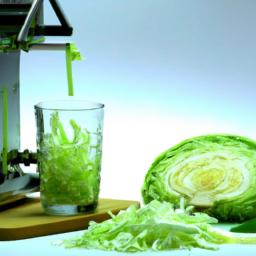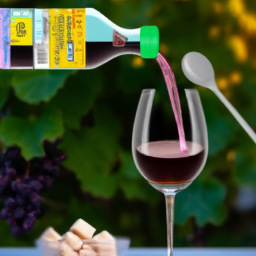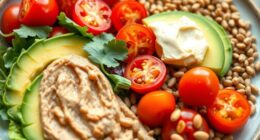I absolutely love eating popsicles, especially when it’s hot outside during the summer months. There’s something special about savoring a chilly, refreshing popsicle that instantly brings back memories of my early days. If you want to experience this wonderful feeling too, keep on reading to discover the magic of popsicles!
And the best part? Making your own popsicles at home is incredibly easy and allows you to get creative with flavors and add-ins.
In this article, I’m going to walk you through the process of making popsicles with juice. Whether you prefer tangy citrus flavors or sweet fruit blends, there are endless possibilities when it comes to creating your own homemade popsicles.
From filling and freezing your molds to adding texture and decorations, I’ll give you all the tips and tricks you need to make the perfect popsicles every time. So grab your favorite juice and let’s get started!
Key Takeaways
- Use a pitcher with a spout or a funnel to avoid spills while making popsicles with juice.
- Add chunks of fresh fruit or a layer of yogurt or whipped cream for texture and flavor.
- Experiment with unique flavor combinations and texture using fruit chunks, nuts/seeds, or pudding/yogurt.
- Proper storage is crucial for freshness, and popsicle molds in the freezer are the most common method.
Gather Your Supplies
Now, let’s grab all our supplies so we can get started on making these delicious popsicles! The first thing you need to do is to prepare a supplies checklist.
You will need popsicle molds, a pitcher, a funnel, a spoon, and your choice of juice. You can also add fruit or other ingredients to your popsicles to make them more interesting and flavorful.
As you gather your supplies, keep in mind that spills can be messy and frustrating. To avoid spills, use a pitcher with a spout to pour the juice into the molds. You can also use a funnel to make pouring easier.
If you accidentally spill some juice, use a spoon or a paper towel to wipe it up. With all your supplies at the ready and some tips for avoiding spills, you’re now ready to start making your popsicles!
How to Fill Your Popsicle Molds
First, grab your favorite beverage container and pour the liquid into the mold until it reaches the fill line. I love getting creative with my popsicle presentation by using alternative molds such as silicone molds in fun shapes or even using ice cube trays for mini popsicles.
Once the liquid is in the mold, it’s time to add in some fun extras. For a fruity twist, I love to add chunks of fresh fruit like strawberries or blueberries to my popsicles. Another fun option is to add a layer of yogurt or whipped cream in between the liquid layers for a creamy texture. With so many options, you can really get creative with your popsicle making!
Now that your popsicle molds are filled with your favorite juice and extras, it’s time to freeze them.
Freezing Your Popsicles
To turn your liquid mixture into frozen treats, simply place the filled molds into the freezer and wait patiently for them to solidify. The time it takes for your popsicles to freeze depends on the size of the molds and the temperature of your freezer. Generally, it takes about 4-6 hours for popsicles to freeze completely.
While waiting for your popsicles to freeze, there are some tips to prevent them from sticking to the molds. First, make sure your molds are clean and dry before filling them with your juice mixture. You can also lightly coat the inside of the molds with cooking spray or oil to help release the popsicles easily.
Another creative way to present and serve your popsicles is to add fruit slices or edible flowers to the molds before freezing. This not only adds a pop of color but also gives your popsicles an extra burst of flavor.
As your popsicles freeze, you can start thinking about flavor combinations to try. Instead of sticking to plain juice, why not mix it up with some fruits or herbs?
In the next section, we’ll explore some delicious flavor combinations to take your popsicles to the next level.
Flavor Combinations to Try
If you want to take your frozen treats to the next level, why not experiment with unique flavor ideas by pairing juice with other ingredients? The possibilities are endless, and you might just discover a new favorite flavor.
Here are three flavor combinations to try:
-
Strawberry-Basil: Blend fresh strawberries with basil leaves and a splash of lemon juice. The herbaceous flavor of basil complements the sweetness of the strawberries, while the lemon adds a tart kick.
-
Pineapple-Coconut: Mix pineapple juice with coconut milk and a pinch of cinnamon. This tropical combination is perfect for a hot summer day, and the cinnamon adds a warm spice note.
-
Watermelon-Lime-Mint: Puree fresh watermelon with lime juice and fresh mint leaves. The mint adds a cool, refreshing element to the sweet watermelon, while the lime provides a tangy twist.
By experimenting with these flavor combinations, you can create popsicles that are both delicious and unique. But why stop there? In the next section, we’ll explore how adding texture to your popsicles can take them to the next level.
Adding Texture to Your Popsicles
I love adding texture to my popsicles! It’s such a fun way to make them more interesting and enjoyable.
Some of my favorite ways to add texture are by using fruit chunks, adding nuts or seeds, and using pudding or yogurt.
Let me tell you more about each of these options!
Using Fruit Chunks
Get ready to add some texture to your popsicles by tossing in chunks of your favorite fruit! Adding fruit chunks to your popsicles not only adds flavor but also makes for a more exciting and visually appealing treat. Here are three ways to incorporate fruit chunks into your popsicle recipes:
-
Layer it up: Layer fruit chunks with your liquid mixture to create a beautiful and colorful presentation. Try layering different colors and textures for a more creative look.
-
Use frozen or fresh: You can use either frozen or fresh fruit chunks in your popsicles. Frozen fruit will help keep your popsicles cold, while fresh fruit will add a juicy texture.
-
Mix it in: Mix fruit chunks directly into your liquid mixture for a more evenly distributed flavor. This is a great way to add more fruit to your popsicles without overpowering the other flavors.
Now that you’ve added some fruity texture to your popsicles, let’s move on to adding nuts or seeds for some extra crunch!
Adding Nuts or Seeds
After trying out the idea of using fruit chunks in my popsicles, I decided to take it up a notch by adding nuts or seeds to the mix. This not only added a unique texture to the popsicles but also made them more filling and satisfying.
I experimented with different nuts such as almonds, pistachios, and walnuts, and even tried using chia seeds and flaxseeds. The possibilities were endless! Adding nuts to the popsicles also gave me the opportunity to play around with new flavor combinations.
I found that nuts paired well with citrus fruits such as oranges and lemons, and also worked perfectly with berries like strawberries and blueberries. It was exciting to see how one simple addition could completely transform the taste and texture of the popsicles.
As I continued to experiment with flavors, I realized that there was even more potential for adding unique ingredients to my popsicles. Up next, I decided to try using pudding or yogurt to create a creamier texture.
Using Pudding or Yogurt
Mixing pudding or yogurt into the popsicle mixture creates a creamy and velvety texture that melts in your mouth like butter on a hot skillet.
Pudding and yogurt are both great options to use when making popsicles with juice. Pudding adds a richer and more indulgent flavor, while yogurt adds a tangy and refreshing taste.
When it comes to health benefits, yogurt is a better option as it contains probiotics that aid in digestion and boost the immune system. Pudding, on the other hand, is high in sugar and calories. However, if you opt for a sugar-free or low-fat pudding, it can still be a delicious addition to your popsicle mixture.
In making popsicles for different age groups, it’s important to consider the sugar content and texture. For toddlers and young children, using yogurt as a base is a healthier option. For teenagers and adults, adding a bit of pudding can create a more indulgent treat.
Regardless of age, adding fresh fruit or nuts can add a nutritious boost to your popsicles.
Making Popsicles for Different Age Groups
When creating popsicles, it’s important to consider the age group you’re making them for in order to ensure that they’re both safe and enjoyable.
For younger children, it’s important to make sure that the popsicles are not too big, as they may be difficult for them to hold and eat. Additionally, using flavors that are not too sour or too sweet is important.
For older children and teenagers, popsicles with unique and creative presentation can be a hit. Incorporating nutritional value into the popsicles can also be a great idea, such as using fresh fruits in the juice mixture.
For adults, popsicles can be a fun and nostalgic treat. Incorporating alcohol into the popsicles can make them a great addition to a summer party or barbecue. For those who are health-conscious, using natural sweeteners and fresh ingredients can make the popsicles a guilt-free treat.
Regardless of the age group, popsicles are a fun and refreshing treat that can be enjoyed by all.
Now, let’s move on to the next step – decorating your popsicles to make them even more exciting.
Decorating Your Popsicles
To add a touch of flair to your frozen treats, try using creative embellishments and fun toppings on your popsicles. Edible glitter or sprinkles are perfect for adding a bit of sparkle to your popsicles. Simply sprinkle the glitter or sprinkles on the outside of the popsicle molds before pouring in the juice or mixture.
Once frozen, you’ll have a beautiful and delicious treat that will impress your friends and family. Another fun idea is to add fruit slices or small candies to the popsicle molds before pouring in the juice. This not only adds a burst of flavor but also creates a fun and colorful surprise when you bite into the popsicle.
Get creative with your toppings and try different combinations to find your favorite. Now that you’ve decorated your popsicles, let’s move on to storing them to keep them fresh and delicious.
Storing Your Popsicles
Decorating your popsicles was a blast, but now it’s time to talk about proper storage to ensure their longevity. After all, you don’t want your hard work to go to waste. Proper storage is crucial to keeping your popsicles fresh, tasty, and enjoyable. There are several ways to store your popsicles, but the most common method is to use popsicle molds and store them in the freezer.
To help you out, here’s a table that outlines the different storage options and their advantages and disadvantages:
| Storage Method | Advantages | Disadvantages |
|---|---|---|
| Popsicle molds in the freezer | Keeps popsicles in their original shape | Limited space in the freezer |
| Plastic bags in the freezer | Takes up less space in the freezer | Can cause popsicles to lose their shape |
| Ice cube trays in the freezer | Easy to portion out | May cause popsicles to be too small |
Proper storage can increase the shelf life of your popsicles and prevent them from becoming freezer burnt or losing their flavor. So, don’t forget to store them properly and enjoy them for days to come. In the next section, we’ll explore alternative ways to freeze your popsicles without using traditional molds.
Alternative Ways to Freeze Your Popsicles
If you’re looking to get creative with your popsicle freezing, there are alternative methods that can add a unique twist to your frozen treats.
One option is to use ice cube trays instead of traditional popsicle molds. Simply pour your juice or mixture into the tray, insert a toothpick or popsicle stick, and freeze until solid. This method creates small, bite-sized popsicles that are perfect for snacking or adding to drinks.
Another alternative is to use reusable molds, which can come in a variety of shapes and sizes. These molds are typically made of silicone or plastic and can be found at most kitchen supply stores or online.
One benefit of using reusable molds is that they are more environmentally friendly than traditional single-use popsicle molds. Plus, they offer the freedom to create unique shapes and designs for your popsicles.
Now that you’ve learned about alternative freezing options, it’s time to move on to enjoying your popsicles and sharing with others.
Enjoying Your Popsicles and Sharing with Others
Once you’ve got your frozen treats ready, it’s time to savor the sweet taste of summer and spread joy by sharing them with friends and family.
Here are a few sharing tips to make your popsicle experience even more enjoyable. First, consider having a popsicle party. Invite friends and family over and have a variety of flavors and presentation options available. You can even set up a DIY popsicle bar with various toppings such as sprinkles, chocolate chips, and fruit.
Another creative presentation option is to freeze popsicles in unique molds or shapes. Using silicone molds, you can create fun shapes like animals, stars, or even your favorite cartoon characters. This adds a level of excitement and interest to the experience, making it even more enjoyable.
And don’t forget to take pictures to share on social media and remember the fun memories made while enjoying your homemade popsicles.
Frequently Asked Questions
Can I use fresh fruit instead of juice to make popsicles?
Yes, fresh fruit substitutions are a delicious and healthy alternative to juice in popsicle making. However, using juice has the added benefit of being convenient and pre-sweetened. Experiment with both to find your perfect recipe.
How long does it take for popsicles to freeze?
As the saying goes, "time flies when you’re having fun."Factors affecting freezing time include freezer temperature and liquid volume. Tips for faster freezing include using smaller molds and placing them in the coldest part of the freezer.
Can I use honey or agave instead of sugar to sweeten my popsicles?
When making popsicles, I prefer to use honey as a natural sweetener because of its rich flavor and antibacterial properties. However, agave is a great alternative for those who prefer a milder taste. When using fresh fruit, adjust sweetness by taste-testing before freezing.
Can I make popsicles without using molds?
I’ve found some alternative methods for making popsicles without molds. One creative solution is to use small paper cups and popsicle sticks. Simply fill the cups with juice, cover with foil, poke a stick through the center, and freeze.
Can I make dairy-free popsicles with almond or coconut milk?
Did you know that dairy products are a common allergen? That’s why I love making dairy-free popsicles with almond or coconut milk. Not only are they allergy-friendly, but the benefits of using almond milk in popsicles are endless. Plus, there are so many different flavor combinations with coconut milk to try!
Conclusion
Well, there you have it – a step-by-step guide on how to make delicious and refreshing popsicles with juice! It’s a simple process that requires just a few supplies and a little bit of patience while waiting for them to freeze. But the end result is definitely worth the wait!
You can get creative with the flavor combinations and textures to make your popsicles even more fun and exciting. And don’t forget to share them with others – as the saying goes, "sharing is caring!"
So whip up a batch of these tasty treats and share them with your friends, family, and neighbors. They’ll love them just as much as you do!
Ilana has been a vegan for over 10 years. She originally made the switch for health reasons, but soon found herself becoming more and more passionate about the ethical and environmental implications of a vegan lifestyle. Ilana is the author of The Graceful Kitchen, a blog all about veganism. She loves to cook up delicious and nutritious vegan meals, and share her recipes with others who are interested in leading a cruelty-free life. Ilana is also a strong advocate for using whole foods as the foundation of a healthy diet, and believes that going vegan is one of the best ways to achieve this.










